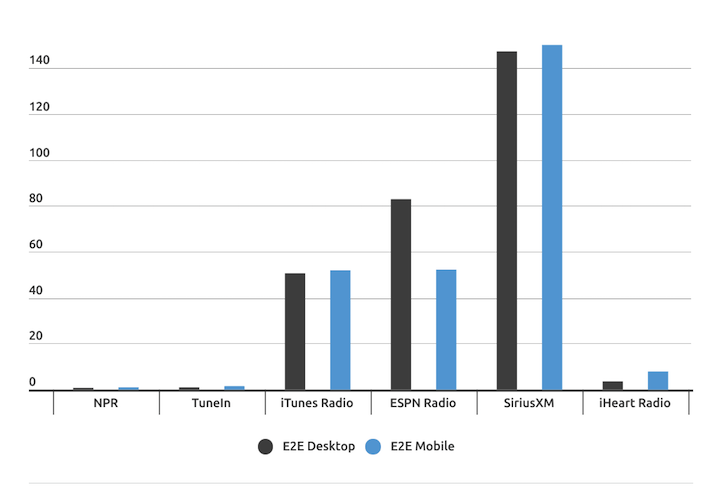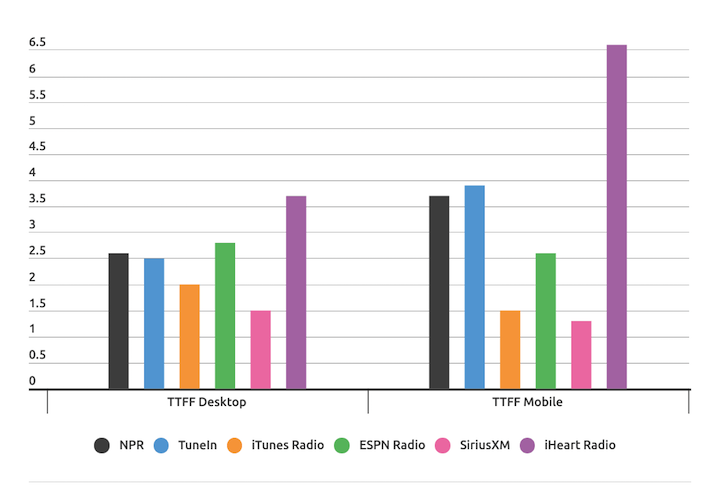Don’t Touch That Dial: Comparing Streaming Radio Latency

If you’re like many of today’s radio listeners, your response to the titular phrase was, “What dial?” In 2008, 94 percent of U.S. adults age 18 to 34 owned a home radio; by 2016, only 68 percent did. But this doesn't mean radio is dying—consumer behaviors are merely shifting. While support for terrestrial radio dwindles, the streaming internet radio market is booming.
Half of all people 12 and older in the U.S. listen to internet radio every week, while 57 percent listen each month: a percentage that nearly doubled between 2010 and 2015. According to XAPP Media’s Internet Radio Trends Report, the growth of monthly streaming radio listeners outpaces that of the U.S. population.
Changing media-consumption patterns are fueling the growth of streaming radio, as well. XAPP's report shows that a whopping 95 percent of internet radio listening happens on mobile devices. What's more, 79 percent of streaming-radio consumption happens while doing other things—with driving making up the greatest proportion of this time. A study by Music Biz Consumer Insights and LOOP finds 31 percent of the U.S. population now has a device for playing mobile audio in the car, and some auto manufacturers even build stereo systems with internet radio functionality.
In response to these changing patterns, a growing number of streaming radio platforms are entering the market. To succeed in this competitive landscape, broadcasters must provide a superior user experience (UX). Most traditional, over-the-air (OTA) radio broadcasts have end-to-end latencies of less than one second. Thus, for some online-radio platforms, streaming in or near real time is an important part of the UX—especially for those that focus on news and sports coverage.
For other platforms that skew toward music or linear programming, perceived quality may be a more important metric: in other words, audio streams must be high-quality and play without buffering; the platform must offer access to a wide range of content and/or exclusive programming; and the app must perform well, without freezing or crashing. Time to first frame (TTFF) is also important in this market. The lower the stream's TTFF, the faster it will load in the app—just like changing that radio dial.
To see how streaming radio broadcasters stack up on these metrics, we put six well-known platforms to the test:
Radio Apps: End-to-End Latency Testing

Radio Apps: TTFF Testing

Now, we'll examine the impact of end-to-end latency and TTFF on the UX for each of these.
TuneIn and NPR: Low-Latency Local Stations and News
Live-streaming radio and on-demand music provider TuneIn Radio performs especially well in our app testing, with close to real-time latency on all devices. We measured one second of end-to-end latency on desktop, and one to two seconds on mobile. TTFF rates are also low: between two and four seconds on desktop, and four to five seconds on mobile.
With over 100,000 stations, TuneIn offers a huge range of options for internet radio listeners, from music to talk to sports. The app uses the GPS on a listener’s device to find local stations, along with thousands of others from around the world. There is a free, ad-supported version, and a subscription-based, Premium version. The Premium tier offers ad-free streaming, audiobooks and streams of live NFL, MLB and Premier League games. Some limited interactivity features are included; for example, users can rewind, pause and record live radio, or share songs on social media.
Low latency is especially important for streaming live sports. High-latency streams can lead to spoiler alerts for fans following along with games on social media, or who have friends and family tuning in through other channels. Those following lower-latency broadcasts will see the game-winning play first—and spoil the experience by posting, calling or texting about it before the streamer has actually heard it happen.
Public radio giant NPR also has very low latency: just one second of desktop end-to-end latency, and one to five seconds on mobile. TTFF was measured at two to three seconds on desktop, and four to seven seconds on mobile. NPR offers streaming radio content via its website player, or through the NPR News and NPR One apps. GPS is used to automatically load the listener’s local NPR affiliate stations, and there is a search function where users can find any NPR station in the country. The music portion of the live radio player offers a broad range of internet and OTA stations, organized by genre.
Low-latency streams are also important for radio platforms that focus on news. Breaking stories, election results or any other time-bound coverage can be spoiled by lower-latency channels, just like sports coverage. After all, only current news is actionable; the older it is, the less relevant it is. NPR’s stripped-down app focuses on reliable performance and helping users access the up-to-the-minute content they care about, rather than offering deep interactivity or extra features.
iHeart Radio Keeps Terrestrial Vibe Alive
The well-reviewed iHeart Radio app boasts a broad range of options for live-streaming listening, with relatively low latency. End-to-end latency is three to four seconds on desktop, and eight on mobile. TTFF clocks in at three to four seconds on desktop and seven on mobile. It offers access to over 1,500 live-streaming U.S. radio stations, including music, talk and college selections, which are searchable by both city and genre. Custom music stations can also be generated based on songs or artists users like.
There is a free, ad-supported version as well as two subscription tiers available. The “Plus” tier is essentially an upgraded radio experience: Users can save songs to playlists, and skip tracks they don’t like an unlimited number of times. The “All Access” tier offers these features plus on-demand music. However, as iHeart Radio CEO Bob Pittman told TechCrunch, “it’s meant to be a radio station with extra features and functionality,” and is not intended to replace on-demand music services such as Pandora or Spotify.
Since only the All Access subscription allows users to listen to specific songs, the app generally mimics the terrestrial radio experience; it’s geared toward those who want to catch their favorite AM/FM stations, listen to specific iHeart Radio DJs or discover new music, rather than pick and choose from old favorites. As a result, iHeart Radio’s mid-range latency numbers make sense: Latency must be low enough to deliver a comparable experience for those listening to terrestrial radio stations, but with the focus on iHeart Radio's own stations and DJs, real-time streaming isn't as important as delivering a quality stream to many listeners at once.
iTunes Radio and SiriusXM: Surf’s Up
The radio platforms of two of digital audio’s biggest names, iTunes and SiriusXM, have the lowest TTFF rates of the platforms we tested. iTunes Radio has TTFF of one to three seconds on desktop, and two seconds on mobile. For SiriusXM, we measured one to four seconds in TTFF on desktop, and two to three seconds on mobile. End-to-end latency scores are notably higher for both of these platforms, however. iTunes Radio scores 47 to 58 seconds on desktop, and 49 to 56 seconds on mobile. SiriusXM has the highest end-to-end latency of all the apps in our test: 145 to 151 seconds on desktop, and 151 to 155 seconds on mobile.
Both platforms offer a broad range of stations, which users can “surf” until they find what they want to hear. When surfing is involved, low TTFF is especially important, so that streams load and start playing quickly. Live-streaming radio listeners expect stations to load as quickly as skipping a track on their smartphone or changing that radio dial.
iTunes offers a large range of online and OTA radio stations, including genre-based music channels; local terrestrial and college radio startions; and big-name channels such as NPR and ESPN. While talk and news stations are available through iTunes Radio, the platform emphasizes music, making its higher latency less impactful for many listeners. However, there is little ability to customize music feeds, and some users report perceived-quality issues, such as a poor user interface.
SiriusXM's internet radio player has over 150 stations, including such big names as CNN, FOX News, NBC, MSNBC and the Howard Stern Show. Sirius is a subscription-based service, offering three tiers based on the content desired The platform is highly customizable, allowing users to not only choose a station, but to micro-adjust the feed based on genre, tempo, time period, world region, popularity and more. Its search feature also allows users to finds stations currently playing the content they want to hear; low TTFF is necessary here, in order to load the desired station in time.
However, Sirius is also distinguished by the fact that it’s the only satellite-based platform in our testing. Additional latency injections are inherent to satellite broadcasts: Not only must they be transmitted from the station to the nearest local server, they must also be sent from there to a satellite in space—then back down to the local endpoint nearest the streamer, all before playback can begin. When literally transmitting data to the moon and back, more time is required than when simply sending a signal across the globe.
However, this built-in latency also allows Sirius users to pause and rewind up to five minutes of live radio streams, and tracks automatically start at the beginning when users choose a station. While satellite streams will never catch up to their OTA counterparts, data caching helps provide high-quality, continuous playback that users can manipulate. These capabilities improve the experience for users who don’t want to miss a moment of their favorite shows and songs.
Conclusions
The radio apps we tested offer a wide range of latency scores. NPR and TuneIn have the lowest end-to-end latency, offering a digital experience that competes with traditional radio as well as a wide range of sports and news content. iHeart Radio offers a “radio-plus” experience with relatively low latency, focused on high-quality streaming at scale.
iTunes Radio and SiriusXM have the highest latency, but the lowest TTFF, making them ideal for station-surfers. As a satellite radio platform, SiriusXM has inherently higher latency—but its pause-and-rewind features help provide a positive UX for listeners who care more about catching all of heir favorite content than about catching it in real time. All else being equal, users will choose the streaming radio platform with the lowest latency; however, for music listeners, this metric may be less important than features such as the ability to play and share certain tracks. Other listeners may be willing to trade higher latency for access to specific content, such as sports stations or talk shows.
Curious about how latency impacts streaming in other markets? Read our posts on latency in gaming, UGC, sports and news.




